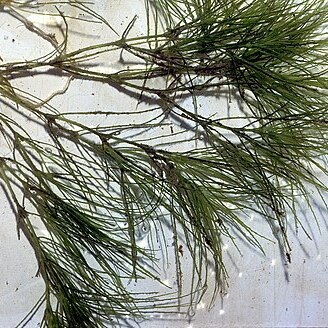Monoecious; dark green; stems 1–2 dm, 0.2–1 mm thick; lvs 0.5–3.5 cm × 0.1–0.2 mm, becoming recurved in age, serrulate with 7–15 multicellular teeth on each side, the base abruptly expanded and minutely fringe-toothed across the subtruncate summit, the teeth extending part-way down the sides of the expanded base; anthers monothecal and with a single microsporangium; seeds 1.5–3 mm, purplish, rather slender and somewhat curved distally, pitted, the areolae quadrangular, ca 0.03 mm high and 0.1 mm wide, in ca 12–18 ladder-like longitudinal rows; 2n=12. Ponds, lakes, and slow-moving streams, often in eutrophic or alkaline waters; native of the Old World, intr. in the U.S. from N.Y. and w. Mass. to Ga. and w. Fla., w. to Ill. and Ark.
Stems 4-25 cm tall, 0.5-1 mm in diam. Leaves recurved, 1-3 cm × 0.5-1 mm; sheath ca. 2 mm; auricles truncate to rounded, with more than 10 teeth on upper and outer sides of leaf margin, each side serrulate with 6-12 teeth, apex acuminate. Plants monoecious; flowers yellowish green. Male flowers elliptic, 0.5-1.5 mm; spathe with a short neck, with brownish spine cells at apex; anther 1-thecous. Female flowers ca. 2 mm; style 1-1.7 mm; stigmas 2-lobed. Fruit linear-ellipsoid, 2-3 × ca. 0.5 mm, narrowed and slightly curved at apex. Seeds narrowly ellipsoid, with many rows of transversely elongated ladderlike pits; areoles fusiform. Fl. and fr. Jun-Oct. 2n = 12*, 24*, 36, 46, 56.
Stems profusely branched near apex distally, 11--120 cm ´ 0.2--1 mm; internodes 0.5--5.8 cm, without prickles abaxially. Leaves usually recurved with age, 0.5--3.4 cm, stiff in age; sheath 1--3 mm wide, apex truncate to auriculate; blade 0.1--1.2 mm wide, margins conspicuously serrulate, teeth 7--15 per side, apex acute, with 1--2 teeth, teeth multicellular; midvein without prickles abaxially. Flowers 1--2 per axil, staminate and pistillate on same plant. Staminate flowers in distal axils, 1.9--2.2 mm; involucre 2-lobed, beaks 0.4--2.1 mm; anther 1-loculed, 0.3 mm.


